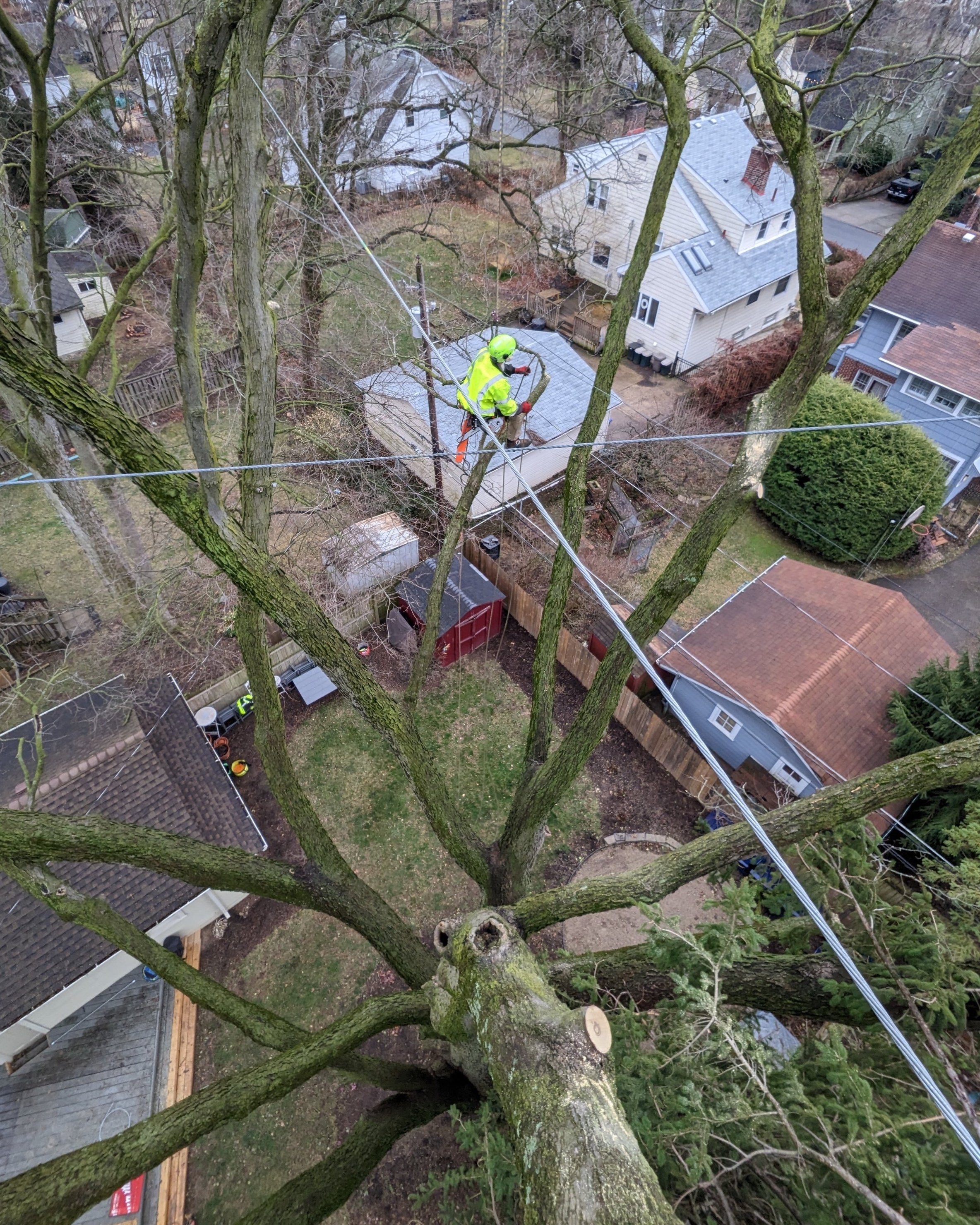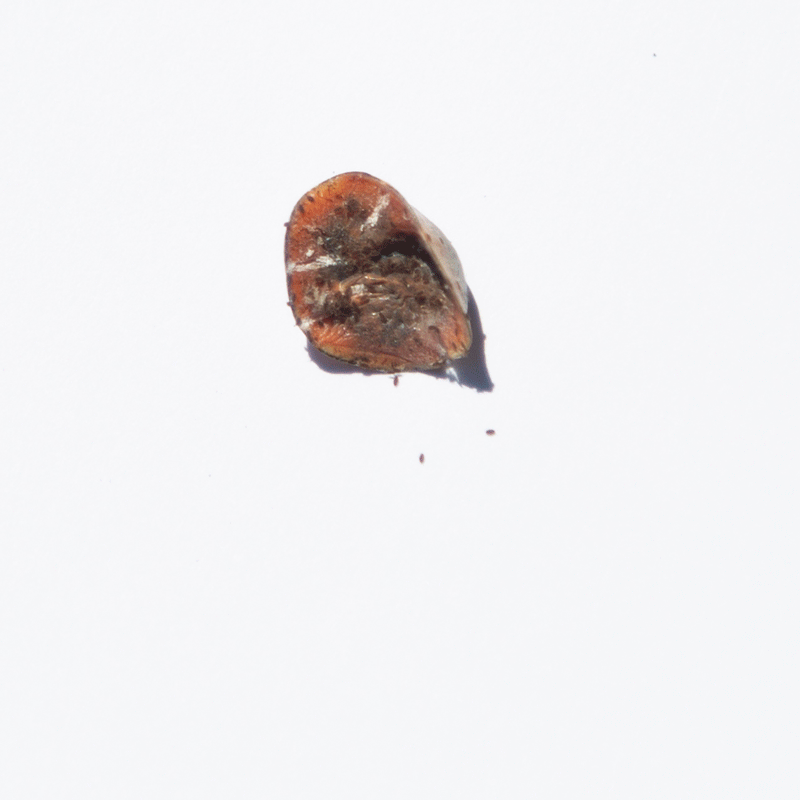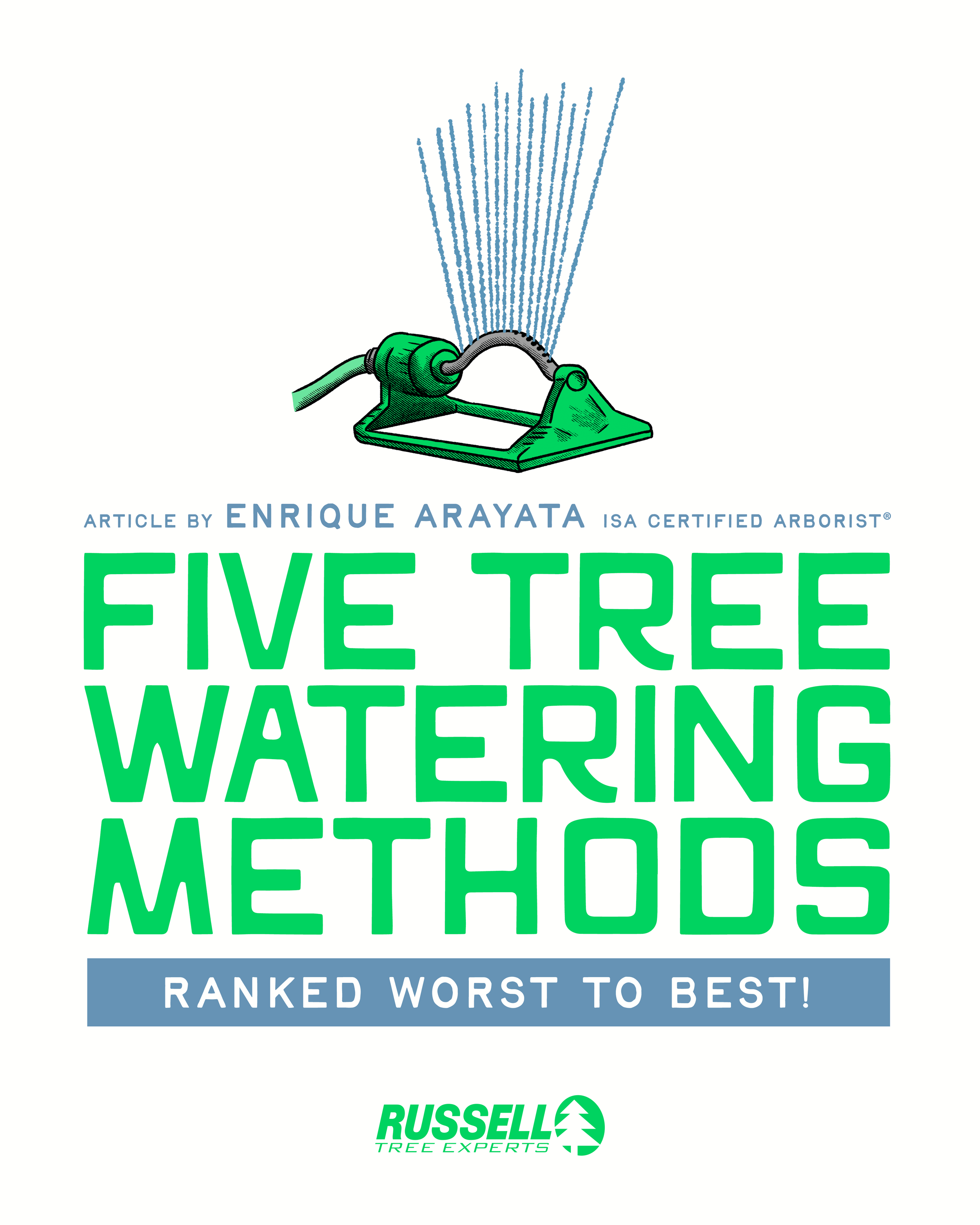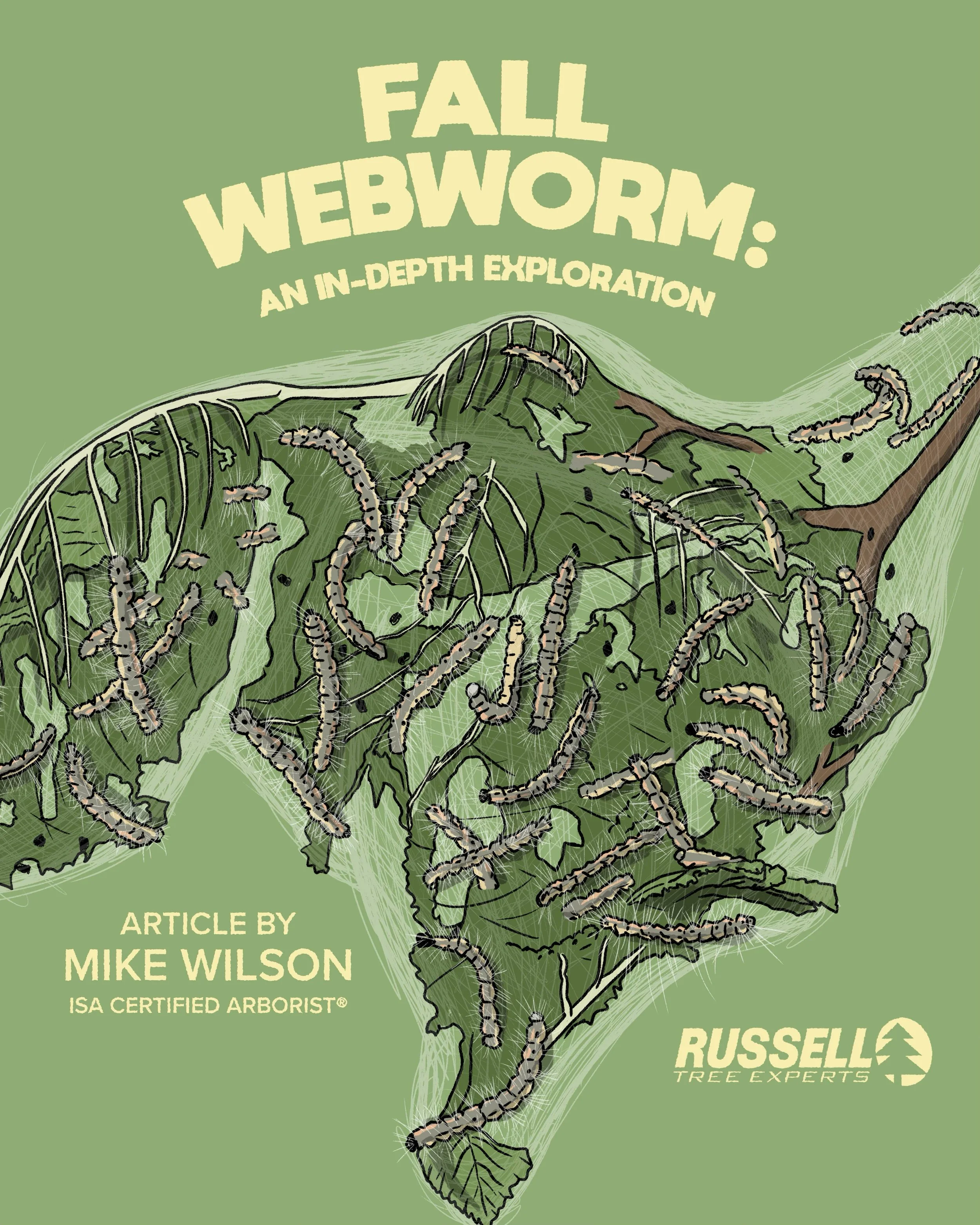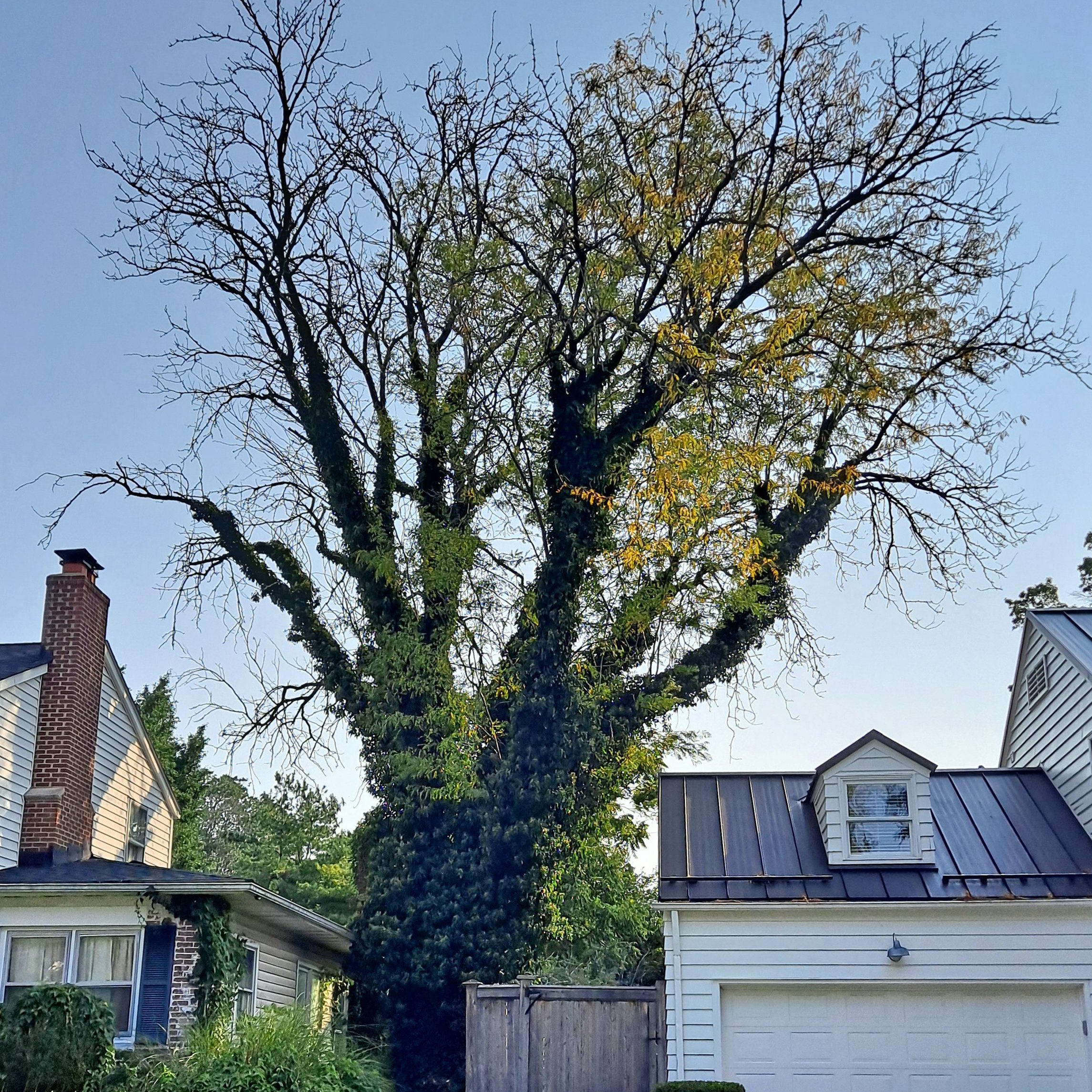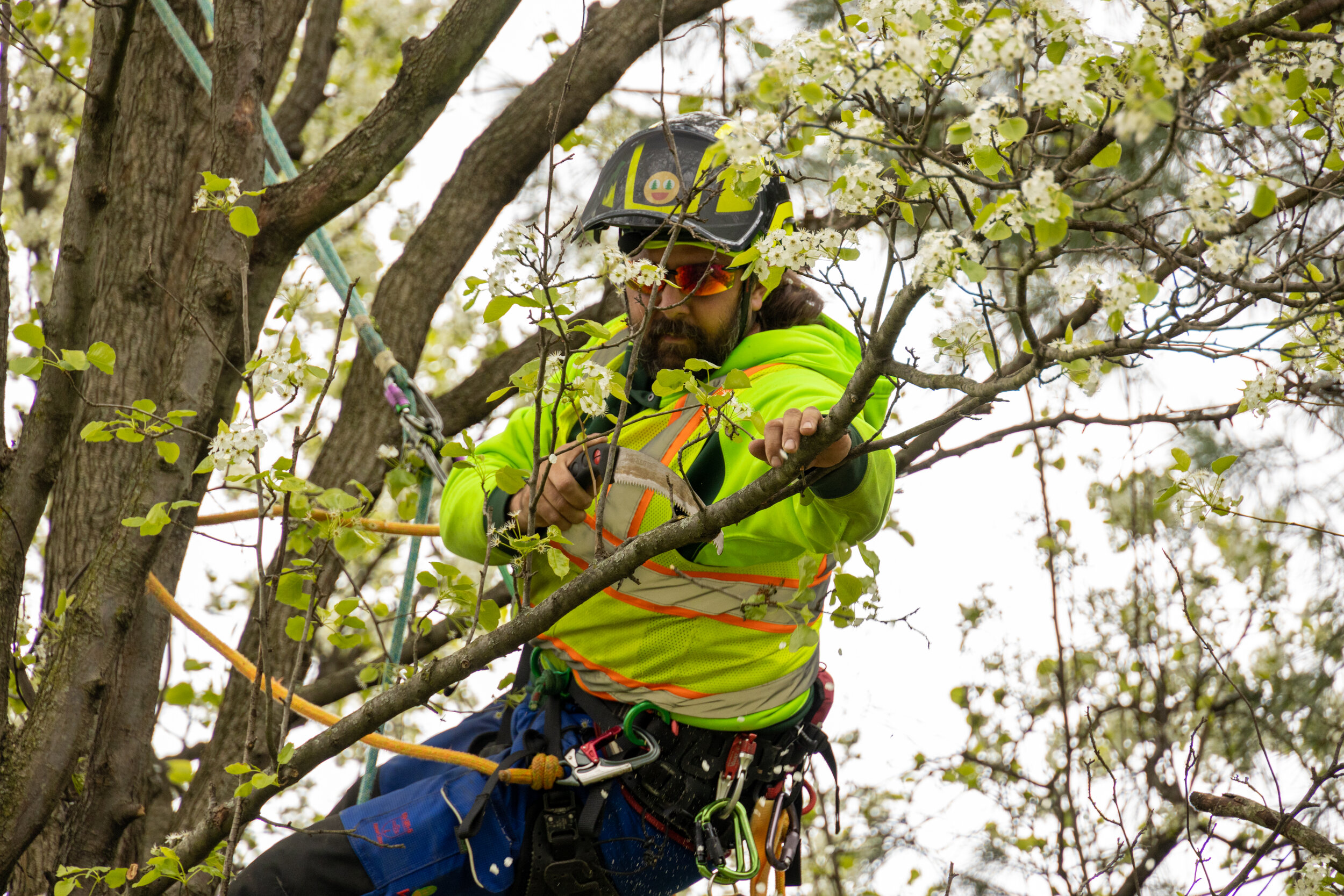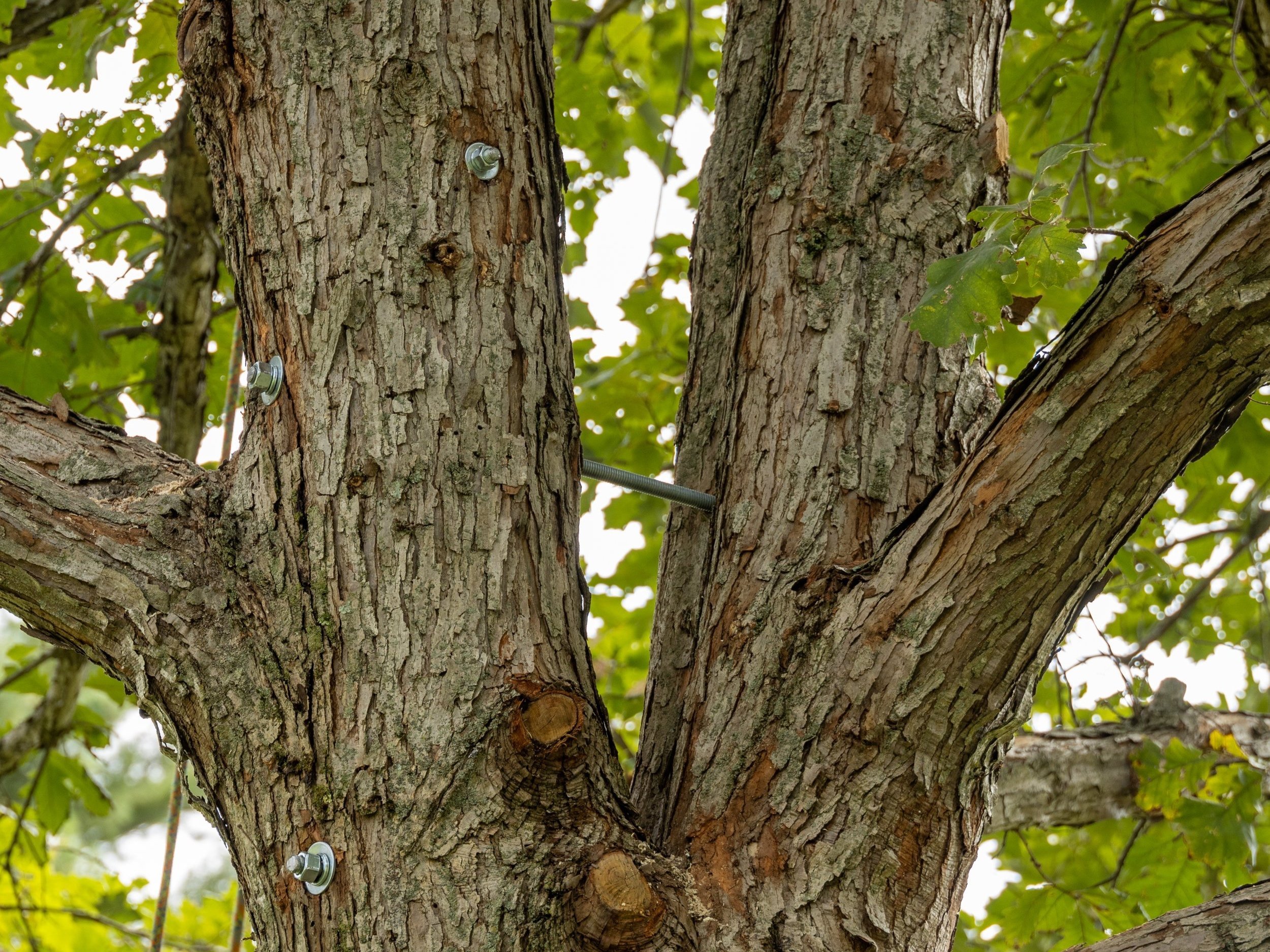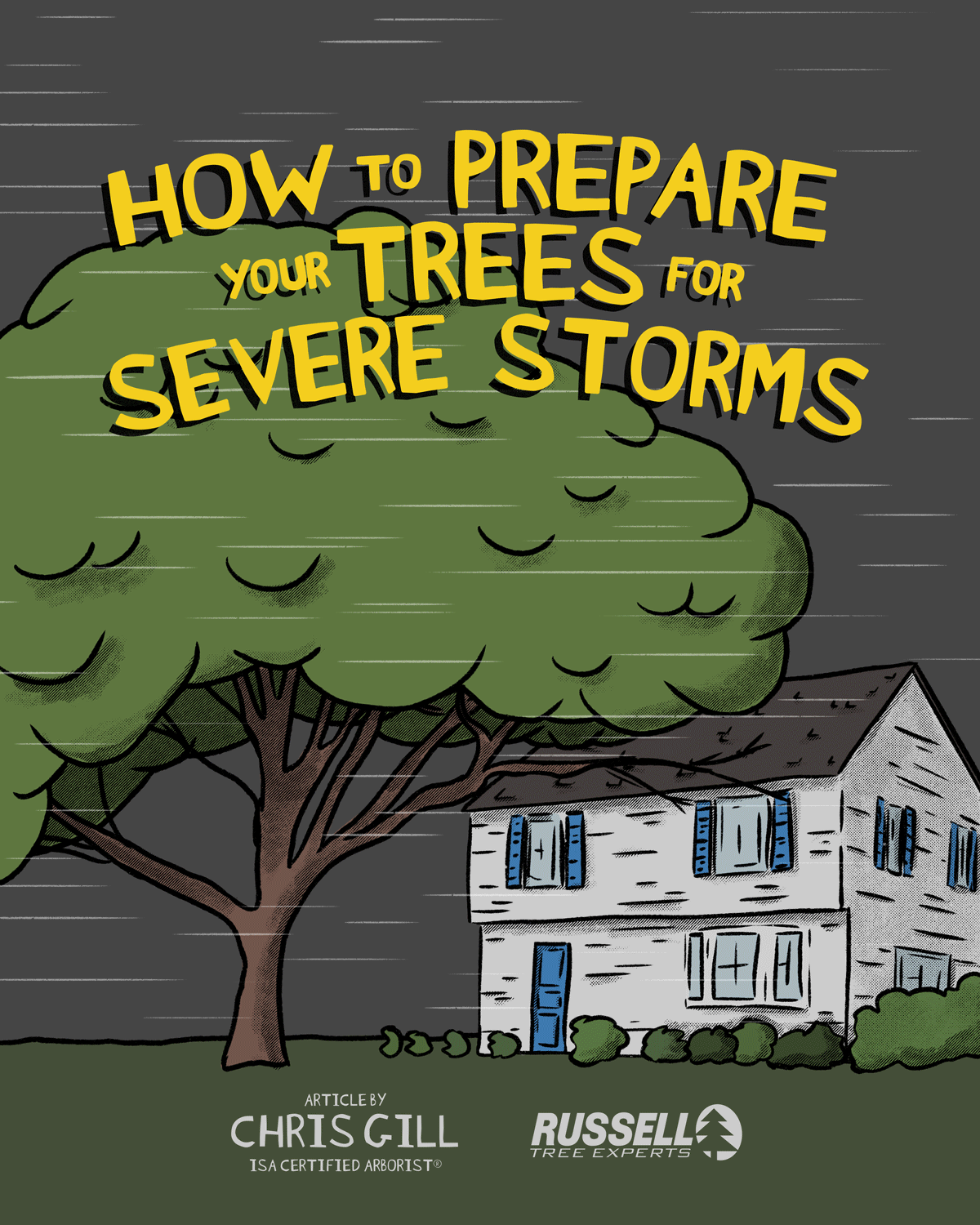The fall season is approaching, and cooler weather is hopefully just right around the corner. With changing temperatures, all our trees are going to be going through a change as well. As we enter the dormant season, we will be gifted with…
Anatomical Upgrades for Your Trees!
When you think of anatomy, what comes to mind? I think of humans specifically, and learning about the wonderful bone and organ systems in our body in middle school science class. You may think about the anatomy of various animals and how there is an abundance of variety depending on where you are in the world, but how often do we consider the anatomy of trees?
Surely trees are just trees, right? They grow without us even considering how or why they may grow in the ways that they do. We may be blissfully unaware of their anatomy or structure until we are confronted by the reality of a winter ice storm or a summer thunderstorm. Oftentimes, we may find trees with less-than-desirable structure having taken damage after these events, or worse, having caused property damage along with their own demise!
Two examples of trees with codominant stems
You may be asking yourself, what does poor tree anatomy look like? The answer to that question deserves its own article, however a majority of tree structural problems can be narrowed down to codominance, and that is what I want to address in this article. Codominance is when a tree has two or more similarly-sized trunks emerging from the same location and forming a distinct “V” shaped union. There are varying reasons as to why a tree may be codominant, and some species have natural habits that lend themselves to becoming codominant.
Visual representation of codominance by Jacob Nau
To give you a visual representation of codominance, bring your elbows together in front of your chest, with your palms facing you. Now, spread your wrists apart, keeping your elbows together to form a distinctive V shape. Opening up your fingers you can picture the crown of a tree. Seems like an awkward, weak position to be in, right? Now, imagine adding the weight of tree branches, leaves, rain and 15-50 mph wind gusts, etc. (trees can go through a lot!), while you strain to keep your elbows together, and you can begin to imagine why a codominant union (V-shaped union) in a tree is not anatomically advantageous.
So what can be done to fix, or even prevent, codominant structure in a tree? The answer to this question largely depends on the age of the tree. If your tree is young and generally under the age of approximately 20 years, then a structural pruning plan can be performed to help guide the tree out of its codominance over the next 5-10 years.
However, if your tree is large and mature, there are a number of services that can be used to help support your tree's anatomy. Those services include:
End-Weight Reductions
Reduce the length of long, lateral branches in the tree’s crown to reduce the weight and levering effect on the codominant union below. Typically performed before or with a cabling support system.
Jacob Nau performing an end-weight reduction on a tree.
Cabling Support System
Install a single, or multiple, static steel cable(s), or dynamic rope cable(s) in the tree’s crown to support the codominant union below.
A static cabling system in a Hackberry tree in Clintonville, Ohio.
Through-Brace Support System
Install a system of steel threaded rods into the codominant union to strengthen that area of the trunk. This is usually performed in-tandem with a cabling support system.
Top Left: Final result of a brace rod installation. Top Right: Close-up of a singular, installed brace rod. Bottom Left: Side profile of two installed brace rods. Bottom Right: A brace rod about to be inserted.
Propping Support System
Install a single, or multiple, semi-permanent wood prop(s) to support a lower, large lateral limb to ease the strain on a codominant union. This is a more unique way to support the tree's anatomy, specifically for low, long, and lateral limbs that are difficult to support with a cabling system.
A tree prop supporting a limb from the Angel Oak tree in South Carolina.
All of the services listed above, including the young-tree structural pruning, are services we perform at Russell Tree Experts. I highly encourage you to look out your window and consider your tree's anatomy! Can they be supported? Is it time for an anatomical upgrade? If so, give our local office a call at (614) 895-7000 and we will happily connect you with one of our Regional Managers to assist you in determining the best course of action for your trees!
Sincerely,
Jacob Nau I Training and Development Manager, Russell Tree Experts
Jacob is an ISA certified arborist and joined RTE in 2018. He has been involved in tree care for over 10 years. He enjoys climbing trees both recreationally and professionally and in his free time, he loves spending time with his family.
Magnolia Scale: They're Back!
By Mike McKee
ISA Certified Arborist®
August 7, 2025
Is your magnolia tree turning black? Is it attracting ants, flies, bees and wasps? Is there a sticky substance covering the leaves and everything under the plant? If you look closely, you will also see white blotches on the twigs throughout the tree.
Over the last few years, this recent invasion of magnolia scale in central Ohio has been intense and unlike what I have observed back in the 2010s. They happen to thrive in warm summers with abundant moisture. The population is building and is very apparent this year.
The insect overwinters on twigs and is inconspicuous to the untrained eye until it starts feeding and producing honeydew. Honeydew is the very sweet, sticky substance secreted by the insect that in turn coats the leaves and anything under the plant. This is what attracts other insects to the plant. Eventually the insect covers itself with a waxy coating that protects it while feeding. These are the white blotches we are now seeing on the plants starting early summer through August.
Nymphs emerging from a recently plucked adult Magnolia Scale
The juvenile stage of magnolia scale emerges from these waxy coatings (the adults) in mid to late August through September as crawlers. This is when scale are most vulnerable to insecticides and we attempt to control their population. We typically recommend 2 to 3 topical insecticide sprays during this period spaced a couple weeks apart for the best control of the insect due to the extended emergence. During seasons with larger infestations, it is unlikely that insecticide sprays will completely eliminate this insect. The overall goal of plant healthcare is to keep the population at a threshold that minimizes damage and maintains aesthetics of the host tree.
If the tree’s owner is concerned about the population of magnolia scale before the appropriate window for insecticide applications is open, there are a few DIY options that can be done. First, the insects can be scrubbed off from branches and leaves in June and July. This is when the adults are visible before the hatch begins. You could also prune out heavily infested Interior branches to help reduce numbers. Be sure to completely dispose of any pruned branches as the insect will still hatch. Spraying the trees with a medium pressure garden hose can also eliminate some insects as well as reduce the honeydew on the plants.
The insects feed by sucking sap out of the tree. If left untreated the scale population can grow to levels that will cause decline and eventual death in your tree.
Another issue with magnolia scale is the occurrence of sooty mold which is a byproduct of the honeydew produced by the scale. It is a black fungal growth which is what most people notice first. Although this generally does not harm the tree, it is very unsightly.
In closing, if you suspect your magnolia tree has magnolia scale, give us a call at (614) 895-7000 or visit RussellTreeExperts.com/Quote and one of our 25+ ISA Certified Arborists® will visit your property to come out and complete an inspection! From there, we can recommend the best management strategy for your magnolia tree. Timing is everything.
Please note: This article was originally published on 8/9/2023 and was revised and republished on 8/7/2025.
ADDITIONAL ARBOR ED™ ARTICLES!
Mike McKee | Regional Manager, Russell Tree Experts
Mike graduated from Hocking College in 1983 with a degree in Natural Resources specializing in urban tree care. He has been an ISA Certified Arborist® since 1991. Mike started his career in the private industry in 1985 before becoming a municipal arborist in 1989. He retired after serving thirty years before joining us at Russell Tree Experts in Sept. of 2018. His love of trees has never waned since trying to climb up the ridges of the massive Cottonwood tree in front of his childhood home.
English Ivy: the Silent, Selfish Assassin
By Krista Harris
ISA Certified Arborist® OH-6699A
February 20, 2025
English ivy climbing the trunks of your trees can look so natural and attractive in the landscape. It is a lovely and effortless groundcover with glossy, emerald, evergreen foliage. However, English ivy is also a non-native species in the US and will clamber defiantly into your tree’s canopy, threatening the tree’s ultimate survival. You may be tempted, as I have been, to allow this beautiful European invader to engulf the scaffold limbs of your defenseless trees, but please do not be misled by this aggressive charmer. English ivy seeks to deprive your trees of water and nutrients at first, and over time, envelop the tree’s crown and hinder its ability to create food for itself through photosynthesis. The tree is ultimately outcompeted by the vine and slowly declines, while the ivy thrives on its new framework, acquiring all the water, soil nutrients and sunlight for itself.
English ivy can be a very heavy burden for your tree to bear. It can ascend 100’ and achieve 12” diameter stems. The sheer weight can weaken limb attachments, causing failure of limbs or entire trees, especially in wind or snow events. Vigorous vines can block natural air and sun penetration to the bark and encourage pest and disease development. When bark is thickly concealed by vines, tree decay and diseases are also very difficult to observe and can go unnoticed.
If you have unwittingly endangered your trees by allowing English ivy to establish itself on their bark, take action now to exterminate this clingy aggressor. The vines should be cut at the base of the tree, removing a 2-3” section from each stem. Repeat this process at 4-5’ up the trunk. Carefully spraying or painting the section still attached to the roots with herbicide will help ensure the ivy does not regrow. Maintaining all English ivy 3-4’ away from the trunk is also a great habit. Do not attempt to remove the severed vines from the tree’s bark. This very grippy greenery is firmly attached using modified stem roots called “hold fasts” and removing the vine will remove the tree bark as well. The remaining, now dead, vines can be safely removed without causing damage to the bark in 2-3 years, if you find them unsightly.
4 weeks after Russell Tree Experts abated the English ivy on a large American sycamore specimen
For a free tree quote from one of our 20+ ISA Certified Arborists®, please give our local office staff a call at (614) 895-7000 or visit RussellTreeExperts.com/Quote! One of our skilled arborists can tackle this important, tree life-saving task or any other tree care needs! Your trees will express their gratitude with many more years of healthy, unrestricted growth!
[Please note: This article was revised and republished on 2/20/25 from its original publish date of 3/10/23]
ADDITIONAL ARBOR ED ARTICLES!
Krista Harris | Journeyperson, Russell Tree Experts
Krista grew up in the central Ohio area and became an ISA Certified Arborist® in 2017. She graduated from The Ohio State University with a Bachelor of Science in Crop Science and a minor in Plant Pathology in 2000 and has been in the green industry ever since. Her favorite trees are the American sycamore, American beech, and giant sequoia. [BS in Horticulture Crop Science, The Ohio State University / ISA Certified Arborist® OH-6699A / ODA Comm. Pesticide Lic. #148078]
Why is Tree Pruning Important?
By Enrique Arayata
ISA Certified Arborist® OH-7252A
June 26, 2025
Tree care comes in many forms: insect and disease management, fertilization, cabling, lightning protection, removal, and last but not least, pruning! Today, let’s talk about the importance of tree pruning and the various reasons why a tree may need pruned.
ISA Certified Arborist Andy Bartram making a tree pruning cut!
Tree pruning is the selective removal of branches from a tree with the general goal of improving the overall quality of the tree, whether it be for safety, health, structure, fruit and flower production, aesthetic appearance, and more. Some may view pruning as unnecessary as there are hundreds of thousands of beautiful, healthy, and unpruned trees out in the world that have grown successfully without human intervention. Although this is true, there are also many trees out in nature that are dead, dying, or unpleasant to look at. A native volunteer tree out in nature grew naturally from one of hundreds of seeds and competed with all the surrounding trees for resources. They are tough and independent and do not need any human assistance. However, the same cannot be said for a single tree or sapling planted by a human in a site where that tree might not have ever grown there naturally. These human planted trees often need extra care like watering, mulching, and fertilization in order for them to be vigorous, healthy, or aesthetically appealing.
A tree sapling planted during one of our TREE FOR A TREE® tree planting community events!
“Pruning” differs from “trimming” as pruning prioritizes a tree’s health and structure. Only the necessary limbs are removed and aesthetic appearance is a byproduct. With “trimming”, plants, shrubs, hedges, and trees are trimmed with the goal of improving their appearance. Depending on the individual trimmer, health and structure may be sacrificed in order to attain a certain look. Trimming can also cause problems as limbs might not be cut back to a spot conducive for compartmentalization and may invite pests or diseases to invade the tree.
Our team member Andrew making a tree pruning cut!
A tree may need to be immediately pruned if it poses a safety concern, such as in the event of storm damage. If there’s a large or dead limb overhanging something significant such as a house, car, sidewalk, or valuable lawn ornament, that limb may need to be preemptively removed as it could be hazardous during a storm. Additionally, codominant stems, two stems with a tight V-shaped attachment at the union, are an example of limbs with safety concerns as this can lead to included bark, lead to uneven growth in a tree, and also be a structurally weak point in a tree that may fail in high wind, snow, or ice events.
An example of a mature codominant limb. Instead of pruning it at this stage of the tree’s life, the owner decided to have brace rods installed to add additional support to this union.
Our team member Mac pruning a dead limb overhanging a busy road.
If there are any limbs with clearance issues, it may also need to be removed. This applies to limbs that are touching any house siding or utility lines or any low hanging limbs that impede lawn activities or pulling into a driveway.
Another important aspect of tree pruning is for health and structural reasons. A tree’s overall health and structure will increase by removing any dead, dying, damaged, disease-infected, codominant, or crossing limbs. Removal of these limbs promotes new growth and increased flower and fruit production. When a tree is pruned, nearby trees, shrubs, plants, and grass can also benefit by receiving more resources like sun, water, and air. These additional resources can improve aesthetic appearance and promote new growth. If the pruned tree was also close to a window you may even have a better view from inside your house or more sunlight coming in during the day!
Unruly lilacs in need of pruning.
As mentioned earlier, tree pruning can improve aesthetic appearance. Pruning does not focus on looks but removing dead, dying, broken, weak in structure, or clearance-issue limbs generally makes trees look neater, cleaner, and overall better. The pruned tree may not have a specific shape desired by an individual, but it will be healthier and safer. Another factor to consider is property value. An unmaintained tree can look unpleasant, unruly, and unsafe which can hurt the curb appeal and value of a property. When it comes time to sell, having a beautiful, healthy, and pruned tree can potentially increase property value, making it an easy worthwhile investment!
So now that you have read about the various reasons for tree pruning, you may be wondering when a tree should be pruned, how often should a tree be pruned, or how much of a tree should be pruned? The short answer is… it depends! Some trees are best pruned during a specific season and some may have no preference. For example, oak trees are not recommended for pruning from roughly April to October due to the risk of oak wilt. A sugar maple can generally be pruned any time of the year, but it is recommended to prune a sugar maple tree during the summer rather than winter to avoid sap leakage from pruning wounds, which does not pose any significant problem to the tree’s health.
Multiple water sprouts shooting straight up from a larger branch due to stress.
In terms of frequency, younger trees may need to be pruned every two to three years while more mature trees may need to be pruned every three to five years. The specific timing can fluctuate and vary based on planting site, climate conditions, potential insect and disease issues, and more. In terms of how much to prune, there should be no specific goal. Only remove the necessary branches. However, a general guideline is that no more than 25% of a canopy should be removed at one time as the tree may “go into shock” and grow watersprouts in an attempt to replace the stored energy lost from the removed branches.
If you decide to have your tree pruned, two common, incorrect methods of pruning that Russell Tree Experts strongly advise against and do not perform are tree topping and lion’s tailing. Tree topping is pruning to create a rounded canopy that often requires cutting through a stem at an improper location. Lion’s tailing is the removal of many, if not all, secondary or tertiary branches from the interior of the crown, leaving most of the foliage at the edge or top of a canopy. Although the look of both of these tree pruning methods may be desired by a specific individual, they do not improve the overall health or quality of a tree and can actually shorten its lifespan and promote decay.
Examples of improper tree pruning: Tree topping (left) and lion’s tailing (right)
Tree pruning is a very large and vast subject with much to cover. Someone could write a novel about tree pruning and still not cover every single detail. The goal of this article was to discuss the many reasons for tree pruning, not necessarily to teach someone how to become a tree pruning expert. However, we do have an article and a video on the 3 cut method that will be linked down below for anyone interested in learning how to safely and effectively remove a limb! Additionally, more tree pruning-related articles are also down below including 6 harmful tree pruning methods! (You already know 2 of them from reading this article!) As always, if you’re interested in a free tree work quote by one of our 20+ ISA Certified Arborists®, visit RussellTreeExperts.com/Quote or speak to our friendly, local office at (614) 895-7000!
Please note: This article was originally published on 1/12/2023 and was revised on 6/26/2025.
Interested in Pruning Your Own Tree?
ADDITIONAL ARBOR ED™ ARTICLES!
Enrique Arayata I Media Production Manager, Russell Tree Experts
Enrique is an ISA Certified Arborist® and FAA Certified Remote Pilot. In his free time, he enjoys working out, hanging out with his family and girlfriend, video production, photography, cars, technology, and cooking. Enrique has a BA in moving image production with a double minor in film studies and studio art specializing in photography from The Ohio State University, and an AA in web graphic design from DeVry University. His favorite tree is the Kwanzan cherry tree.
The 3 Cut Method
What's Wrong with my Sycamore & Maple?
"Why does my beautiful maple have ugly black spots on its leaves?" "Why is my American sycamore bare this year” …To answer these questions, we need to go back to a chilly, wet evening 5 weeks ago. On May 5th, the temperature dropped overnight to 41 degrees just after an early morning shower that day. We continued this cool, wet trend for 10 lousy days, and…
Pruning Upper Arlington's Oldest Tree
New Disease Control Measures for Oak & Elm Trees
… I hope everyone is having a great week and enjoying this sunshiny weather! I love being able to get outside with my girls and get some vitamin D and open our windows and get some fresh air. With spring around the corner, I wanted to bring to your attention that Russell Tree Experts is implementing some new Oak tree and Elm tree safety procedures to ensure the health and safety of these types of trees in the Columbus area.
Understanding Conifers
Understanding conifers should begin with a few simple definitions to clarify and classify. A conifer is a plant that bears its seeds in cones. When we hear the word cone, we likely think of pine and spruce trees, two types of coniferous trees that are widely found throughout Central Ohio and beyond. Their cones are obvious when they fall and scatter on the ground surrounding the tree. But did you know that yews (Taxus) and junipers are also conifers?
When and How to Prune Lilacs
Common lilacs (Syringa vulgaris) are a favorite landscape shrub here in Ohio and beyond, with flowers that provide beauty and an unmistakable fragrance every spring. Other cultivars of lilacs offer different habits and uses in the landscape, but provide the same display of flowers that we all love. In order to ensure you get the most flowers on your lilac year after year, it’s important to know when and how to prune them.
STOP! DON'T TOP!
The Value of Trees in the Urban Landscape
Ask an Arborist: When is the best time of year to get trees trimmed?
The dormant season is a great time of year to prune your trees, Sandra. This is basically from October through May. In the dormant season, the leaves are off so it is easier to see structural defects within the canopy of your tree. It is also a time of year when there are fewer insect and disease issues that sometimes or attracted to fresh pruning wounds. Sometimes customers have concerns about our cruise being able to identify dead limbs when there are no leaves. This is done by looking closely at the bark and if needed, the color of the cambium layer with a small scratch on the bark of each branch. Long story short: Now is a great time to trim your trees!
-Joe Russell, Russell Tree Experts






